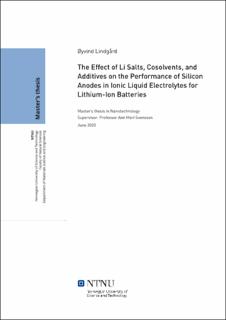| dc.contributor.advisor | Svensson, Ann Mari | |
| dc.contributor.author | Lindgård, Øyvind | |
| dc.date.accessioned | 2021-09-28T18:05:32Z | |
| dc.date.available | 2021-09-28T18:05:32Z | |
| dc.date.issued | 2020 | |
| dc.identifier | no.ntnu:inspera:59544221:52144651 | |
| dc.identifier.uri | https://hdl.handle.net/11250/2785268 | |
| dc.description.abstract | Denne oppgaven fokuserer på å forbedre ytelsen og forståelsen av silisiumanoder i kombinasjon med elektrolytter av ioniske væsker for litsium-ionbatterier med formål om å støtte arbeidet med å utvikle energilagring som er tryggere og har høyere kapasitet. Litsium-ionbatterier har blitt kraftig implementert de siste tiårene og har revolusjonert bærbar elektronikk og lagt grunnlaget for elektrifiseringen av samfunnet, for eksempel via kommersialisering av elektriske biler. Nå har imidlertid grafittanoden i det tradisjonelle litsium-ionbatteriet nådd den teoretiske kapasiteten og det er nødvendig med videreutvikling for at litsium-ionbatteri skal kunne bidra til en grønnere framtid. Silisium er anerkjent som et av de mest lovende anodematerialene i neste generasjons batterier. I tillegg bør et alternativ til dagens brennbare karbonatelektrolytter bli utviklet. Ioniske væsker har, til tross for høy viskositet, blitt vurdert som en ikke-brennbar elektrolytt i mange år. For å videre adressere utfordringene knyttet til silisiumanoder og elektrolytter av ioniske væsker, har denne oppgaven tatt i bruk en tredelt tilnærming som inkluderer (1) å evaluere effektene som to litsiumsalt, litsium bis(fluorosulfonyl)imide (LiFSI) og litsium bis(trifluoro-metansulfonyl)imide (LiTFSI), hadde på opp- og utladingsstabiliteten, rateytelsen og dannelse av SEI ("solid-electrolyte interphase") med silisiumanoder i to forskjellige ioniske væsker, 1-etyl-3-metylimidazolium bis(fluorosulfonyl)-imide (EmiFSI) og trimetyl(isobutyl)phosphonium bis(fluorosulfonyl)imide (P111i4FSI), (2) å vurdere bruken av trietylfosfat (TEP) og 2-trifluormetyl-3-methoxyperfluoropentan (TMMP) som kosolventer med lav viskositet for EmiFSI og (3) å evaluere fluoretylenkarbonat (FEC) som et mulig SEI-dannende tilsetningsstoff i EmiFSI-baserte elektrolytter både med og uten kosolvent. Resultatene viste at LiFSI er det foretrukne litsiumsaltet for P111i4FSI-elektrolytter, men at det er en avveining mellom forbedret kapasistet og Coulombisk effektivitet med LiTFSI og en bedre rateytelse med LiFSI i EmiFSI-baserte elektrolytter. Disse funnene illustrerer hvordan valget av litsiumsalt påvirker celleytelsen og impliserer at nøye vurderinger må gjøres når litsiumsalt skal velges. Videre virker verken TEP eller TMMP å være aktuelle kosolventer for EmiFSI ettersom TEP gjennomgikk en kraftig dekomponeringsprosess under den første oppladingssyklusen og TMMP ikke var løselig i EmiFSI ved de konsentrasjonene som ble testet i denne oppgaven. Bruken av FEC som tilsetningsstoff resulterte i verre rateytelse og større overpotensial, både med og uten kosolvent tilstede, noe som betyr at den ikke er passende å bruke sammen med EmiFSI. Videre forskning bør fokusere på å bruke flere karakteriseringsteknikker for å forbedre forståelsen av SEI-dannelse med LiFSI og LiTFSI, samt evaluere flere alternative kosolventer og tilsetningsstoffer for å forbedre ytelsen av silisiumanoder i elektrolytter av ioniske væsker. | |
| dc.description.abstract | This thesis aims at improving the performance and understanding of Si anodes in combination with ionic liquid (IL) electrolytes for Li-ion batteries (LIBs) for the purpose of supporting the quest for safer and higher-capacity energy storage. LIBs have been widely implemented in the past decades, revolutionizing the field of portable electronics and laying the foundation for the electrification of society, for instance through a widespread commercialization of electric vehicles. However, the graphite anode in the traditional LIB has reached its limiting capacity and further developments to this crucial technology are needed to allow LIBs to fulfill the role they can play in a greener future. Silicon has been recognized as one of the most promising next-generation anode materials. In addition, a replacement of today's flammable carbonate-based electrolytes should also be developed and ILs, despite their high viscosities, have been considered as a non-flammable electrolyte alternative for quite some time. To further address the challenges related to Si anodes and IL electrolytes, this thesis employed a threefold approach including (1) evaluating the effects that two different Li salts, lithium bis(fluorosulfonyl)imide (LiFSI) and lithium bis(trifluoro-methanesulfonyl)imide (LiTFSI), had on cycling stability, rate performance, and solid-electrolyte interphase (SEI) formation of Si anodes in two different ILs, 1-ethyl-3-methylimidazolium bis(fluorosulfonyl)-imide (EmiFSI) and trimethyl(isobutyl)phosphonium bis(fluorosulfonyl)imide (P111i4FSI), (2) assessing the use of triethyl phosphate (TEP) and 2-trifluoromethyl-3-methoxyperfluoropentane (TMMP) as low-viscosity cosolvents for EmiFSI, and (3) evaluating fluoroethylene carbonate (FEC) as a potential SEI-forming additive in EmiFSI-based electrolytes with and without a cosolvent. The results showed that LiFSI is the preferred salt in P111i4FSI electrolytes, but that there is a trade-off between improved capacity and a better Coulombic efficiency for LiTFSI and a better rate performance for LiFSI in EmiFSI-based electrolytes. These findings illustrate how the choice of Li salt affects cell performance and imply that careful consideration must be taken when choosing the electrolyte salt. Further, neither TEP nor TMMP appear to be suitable cosolvents for EmiFSI as TEP underwent a severe decomposition during the first charge cycle and TMMP was not miscible with EmiFSI at the concentrations tested in this thesis. The use of FEC as an additive resulted in worse rate performance and greater overpotentials, both with and without the cosolvent present, meaning that it is not suitable to be used with EmiFSI. Further research should focus on using additional characterization techniques to improve the understanding of SEI formation with LiFSI and LiTFSI salts, in addition to evaluating further alternatives for cosolvents and additives to improve the performance of Si anodes in IL electrolytes. | |
| dc.language | | |
| dc.publisher | NTNU | |
| dc.title | The Effect of Li Salts, Cosolvents, and Additives on the Performance of Silicon Anodes in Ionic Liquid Electrolytes for Lithium-Ion Batteries | |
| dc.type | Master thesis | |
